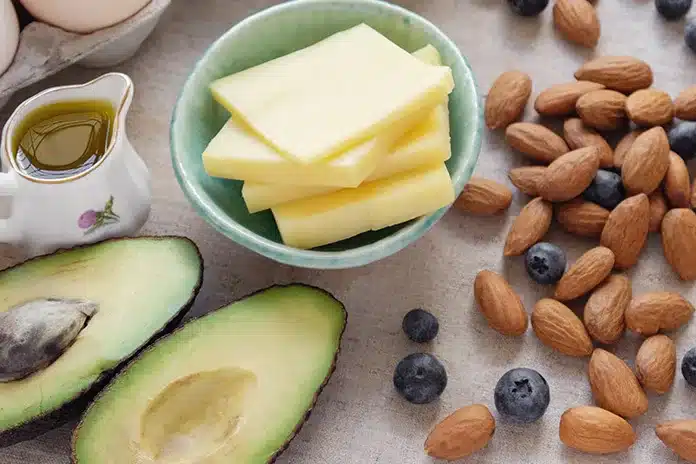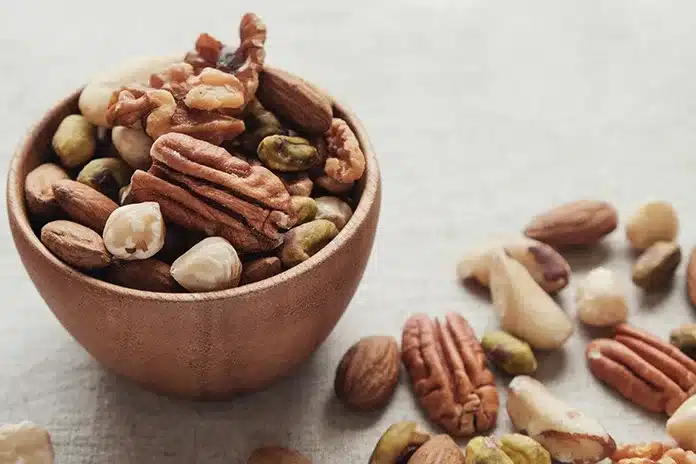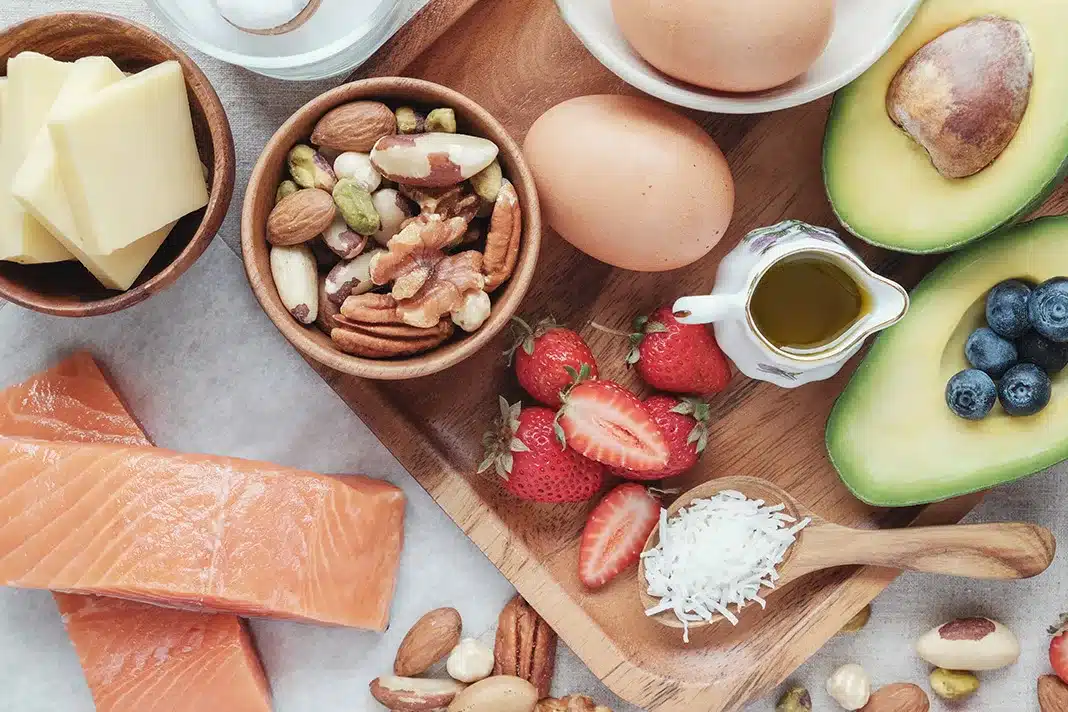Nutritionist Georgia Head discusses the keto diet side effects and gives us the low-down on the latest dieting trend making waves in the wellness industry
By Robin Swinkels
As the notion of a healthy lifestyle becomes more popular, dieting trends seem to be multiplying and in the sea of new supplements, work-out routines and crazes, the ketogenic diet – more commonly known as the keto diet – stands apart from the crowd. Here, Fresh Fitness Food nutritionist Robin Swinkels shares the keto diet side effects and the things to know now.
What is a ketogenic diet?
A ketogenic diet is a diet with a very high fat content, moderate protein and very low carbohydrate content. There are variations on how the diet might be implemented, but on a typical keto diet about 75-80% of your calories come from fat and the rest from carbs and protein.
Our bodies mainly use carbohydrate and fat for energy. When the diet is low in carbohydrate, our bodies will produce ketones from fat to fuel cells that can normally only use glucose (the simplest form of carbohydrates) to function (mainly our brain and nervous cells). Ketones, unlike fatty acids, can cross the blood/brain barrier.

The diet was originally developed to treat epilepsy in children as the ketones reduce the occurrence of epileptic seizures. The ketogenic diet is now popular for its alleged “fat burning” properties. The idea is that it gears your metabolism towards burning fat rather than carbohydrate and that this will aid fat loss. The critical point that is often conveniently left out is that this will only work if you are in a calorie deficit, meaning you eat less calories than you burn. If you still eat the same number of calories you will not lose weight on a ketogenic diet.
What are the benefits?
If you are an epileptic child it may help control your epileptic seizures. If you are healthy and just looking to lose some weight there are none. There is nothing that a ketogenic diet offers that a regular calorie restricted diet cannot. That is unless you really love fatty foods, in that case, it may be the diet of your dreams.
Can you give examples of some foods that fall into the keto category?
Any food that has a high fat content and little of anything else basically, so things like olive oil, butter, avocados, fatty meats like beef and pork, salmon, eggs, nuts, peanut butter, cheese and cream. The only type of carbs you can really have in order to give your meals volume and ensure you maintain a healthy micronutrient profile are vegetables.

To give you an idea of how much you can have, consider the following example of a typical ketogenic diet: say you’re having 75% of calories from fat, 15% protein and 10% carbs, on a 2000 calorie diet that works out at only 50 g carbs per day, which is roughly the amount in a medium-sized banana and apple, 5 digestive biscuits or one plain bagel.
What are some examples of food that a keto diet eliminates?
Anything with a high carbohydrate content, so any starch like potatoes, bread, rice and pasta but also sugar and sweets. Lean protein sources also don’t really fit in because often fats come paired with some protein in foods. To meet your fat intake of 75% of calories it can be difficult to keep your protein intake low. There aren’t many foods that are 100% fat and to eat these foods all the time can be a struggle. To use the example diet again, 75% of 2000 calories is 167 g fat which is about the amount of fat in 200 g butter.
Are there negative keto diet side effects?
Chances are that your saturated fat intake will increase considerably on a ketogenic diet. Excessive intake of saturated fats has been linked to a number of diseases such as Alzheimer’s, kidney disease and some types of cancer.
The protein content of the diet is too low for most people, especially if you are training with weights and looking to retain or grow muscle mass. To use the example diet again, 15% of 2000 calories works out at only 75 g protein. The recommended intake for protein ranges from 1.6-2.5 g per kg body weight per day. If you are in a calorie deficit and train with weights, you are on the higher end of that recommendation and 75 g is not going to be close to enough. But even on the lower end of the recommendation, for example for a sedentary person who doesn’t train, 75 g of protein will not cut it for most.

The low carbohydrate content of a ketogenic diet means you have to cut out many types of fruit and vegetables which are higher in carbohydrate. Fruit and vegetables provide fibre, vitamins and minerals needed to stay healthy, therefore being on a ketogenic diet for a long time can lead to constipation and micronutrient deficiencies.
Apart from that, if you are in a calorie deficit you will be hungry at some point. To counteract that you want to eat satiating foods that keep you full for longer. Protein and fibre rich foods do exactly that, but you need to limit your intake of these on a ketogenic diet.
Furthermore, if taken to the extreme, there is a risk of developing a condition called ketoacidosis. This occurs when the concentration of ketones becomes too high and lowers the pH of the blood. In other words, your blood gets too acidic and this can be lethal.
How does a Keto diet affect physical performance and energy levels?
Carbohydrate is the preferred fuel for our muscles. Therefore, if you’re doing a lot of training, your performance will suffer. Obviously there will always be some individual variability, some people cope better with lower amounts of carbs than others but overall performance will not be as strong as with carbs for most people. If you’ve been on a keto diet for a while you may adapt somewhat, but performance on a keto-diet isn’t quite the same as with carbs. Your energy levels will also be low. Especially the first few days when you’re not used to the diet yet. As mentioned our brains can only use glucose or ketones so your head may also feel cloudy, and you might struggle to focus.

If you are trying to lose weight this works against you. Exercise is an essential part of staying healthy and it can help to add to your calorie deficit on a fat loss diet. However, if you don’t have the energy to train, you will be less active and burn less calories which in turn jeopardises your calorie deficit.
In terms of practicality, how easy is it to follow a keto lifestyle?
A ketogenic diet is very difficult to sustain because it is very restrictive. The food options are very limited, so you’ll need to eat the same few foods over and over again. This is difficult for most people as variety is indeed the spice of life.
Are there any people who shouldn’t adopt a Keto diet?
Most people. Unless you are an epileptic child, this diet probably isn’t for you.
Would you recommend the diet on the whole?
No, any diet that simply cuts out a macro or food group is not something I’d ever recommend. It’s unsustainable and unnecessary. The ketogenic diet combined with a calorie deficit offers no advantage over a normal calorie restricted diet where you get a balanced intake of protein, carbohydrate and fats. If anything, the ketogenic diet is probably worse if you have a serious fat loss goal due to the low protein content, lack of variety, lack of fibre to keep you feeling full and the negative effect on training.

Nutrition and dieting aren’t complicated. To lose weight you simply need to be in a calorie deficit for a prolonged period of time. The main reason why people fail to lose weight and more importantly, keep it off, is adherence. You may be able to follow the ketogenic diet for a week and you may even lose weight to begin with, but it’s not something you can maintain in the long run.
A diet needs to be sustainable in order to produce long-term results. So, my advice would be to focus on making lifestyle changes rather than following an extreme diet as a ‘quick fix’. What tends to work best, is creating a calorie deficit by eating slightly fewer calories than you need and exercising to build muscle and increase the number of calories you burn. Eat a diet based on whole foods with sufficient protein, vegetables and fibre and have your alcohol and treats in moderation.







